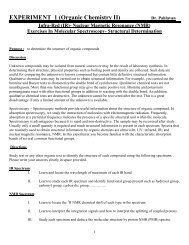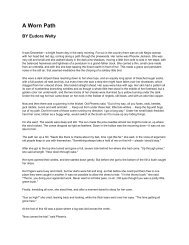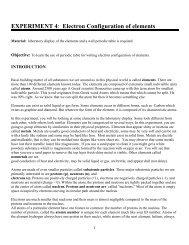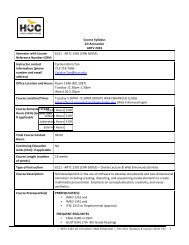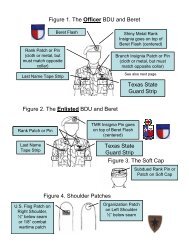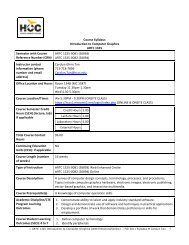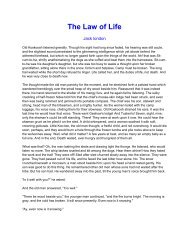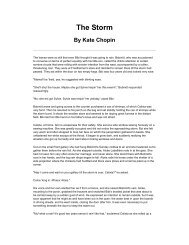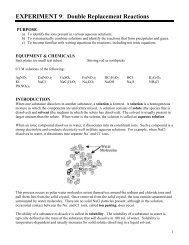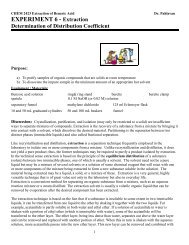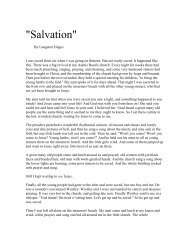EXPERIMENT 4 â Recrystallization of Benzoic Acid
EXPERIMENT 4 â Recrystallization of Benzoic Acid
EXPERIMENT 4 â Recrystallization of Benzoic Acid
Create successful ePaper yourself
Turn your PDF publications into a flip-book with our unique Google optimized e-Paper software.
CHEM 2423 <strong>Recrystallization</strong> <strong>of</strong> <strong>Benzoic</strong> <strong>Acid</strong>Dr. PahlavanA suitable recrystallization solvent should also be partially volatile in order to be easily removed from thepurified crystals. The solvent should not react with the compound being purified and it should have the boilingpoint below the melting point <strong>of</strong> the compound being purified because solid melts before dissolves (oiling out).In selecting a good recrystallization solvent one should also consider flammability, toxicity, and expense.In selecting a solvent consider that like likes like. Polar compounds dissolve polar compounds and non-polarcompounds dissolve non-polar compounds. The most commonly used recrystallization solvents are presented inthe following table.solvent formula polarity boiling point ( 0 C)water H 2 O very polar 100ethanol CH 3 CH 2 OH polar 78methanol CH 3 OH polar 65dichloromethane CH 2 Cl 2 slightly polar 40diethyl ether (CH 3 CH 2 ) 2 O slightly polar 35Organic compounds with one polar functional group and a low number <strong>of</strong> carbon atoms such as methanol,ethanol, and n-propanol are highly soluble (miscible) in water. These alcohols form hydrogen bond with waterdue to the polar –OH functional group. As the number <strong>of</strong> carbons per polar functional group increase, solubilitydecreases. The solubility <strong>of</strong> alcohols with four to five carbons is given in the following table.alcohol formula Solubility (g/100 ml H 2 O)n-butanol CH 3 CH 2 CH 2 CH 2 OH 8n-pentanol CH 3 CH 2 CH 2 CH 2 CH 2 OH 2n-hexanol CH 3 CH 2 CH 2 CH 2 CH 2 CH 2 OH 0.5n-pentanol CH 3 CH 2 CH 2 CH 2 CH 2 CH 2 CH 2 OH 0.1Compounds with six or more carbons for each polar group will not be very soluble in polar solvents but will besoluble in non-polar solvents such as benzene and cyclohexane.If a single solvent cannot be found that is suitable for recrystallization, a solvent pair <strong>of</strong>ten used. The solventsmust be miscible in one another. Some commonly used solvent pairs are water-ethanol, acetic acid – water,ether-acetone. Typically, the compound being recrystallized will be more soluble in one solvent than the other.The compound is dissolved in a minimum amount <strong>of</strong> the hot solvent in which it is more soluble.The following formulas used in solubility problems.% lost in cold solvent = (solubility in cold solvent/solubility in hot solvent) x100% recovery <strong>of</strong> solid = [g (solid ) – g (solid lost)] x 100 / g (solid)2
CHEM 2423 <strong>Recrystallization</strong> <strong>of</strong> <strong>Benzoic</strong> <strong>Acid</strong>Dr. PahlavanExample (1)- The solubility <strong>of</strong> solid “X” in hot water (5.50 g/100 ml at 100 o C) is not very great, and itssolubility in cold water (0.53 g/100ml at 0 o C) is significant. What would be the maximum theoretical percentrecovery from crystallization <strong>of</strong> 5.00 g <strong>of</strong> solid “X” from 100 ml water? Assuming the solution is chilled at 0o C.Percent solid lost in cold water = (solubility in cold water/ solubility in hot water) x100= (0.53/5.50) x100 = 9.64%grams solid lost in cold water = grams mass <strong>of</strong> original solid x percent lost = 5.00 g x 9.64% = 0.482 gg (solid recovered) = g (solid) – g (solid lost) = 5.00 – 0.482 = 4.52 g% recovery = g (solid recovered) x100 / g (solid) = (4.52/5.00) x100 = 90.4 %Example (2) – The solubility <strong>of</strong> compound “X” in ethanol is 0.80 g per 100 ml at 0 o C and 5.00 g per 100 ml at78 o C. What is the minimum amount <strong>of</strong> ethanol needed to recrystallize a 12.00 g sample <strong>of</strong> compound “X”?How much would be lost in the recrystallization, that is, would remain in the cold solvent?amount <strong>of</strong> ethanol needed at 78 o C = (12.00 g)( 100 ml/5.00 g) = 240 mlamount <strong>of</strong> sample remaining in the cold solvent at 0 o C = (240 ml)(0.80 g/100 ml) = 1.9 gor% lost = (0.80/5.00) x100 = 16 % 12.00 x 16% = 1.92 gThe actual laboratory we will do is the recrystallization <strong>of</strong> benzoic acid from water using the temperaturegradient method. <strong>Benzoic</strong> acid is not very soluble in cold water, but it is soluble in hot water. The purpose <strong>of</strong>this experiment is to learn the technique <strong>of</strong> recrystallization by purifying benzoic acid.3
CHEM 2423 <strong>Recrystallization</strong> <strong>of</strong> <strong>Benzoic</strong> <strong>Acid</strong>Dr. PahlavanExperimental ProceduresUsing a weighing paper, weigh out about 1.00 g <strong>of</strong> “impure <strong>Benzoic</strong> acid for recrystallization” and transfer it toa 125-ml Erlenmeyer flask. Add about 20 ml distilled water, using a graduated cylinder, to the flask and bringthe mixture to the boiling point by heating on a hot plate, while stirring the mixture and boiling gently todissolve benzoic acid completely. (Fig 1)Erlenmeyerflaskbenzoic acidsolutionhot plateFig 1- Dissolving benzoic acidRemove the flask from the hot plate and examine the solution. If there are particles <strong>of</strong> benzoic acid stillundissolved, then add an additional amount <strong>of</strong> hot or cold water in small increments and resume heating thesolution. The objective is to dissolve the entire solid in only as much as hot or near boiling solvent (water) as isnecessary. Do not add too much water or the solution will not be saturated and the yield <strong>of</strong> purified benzoicacid will be reduced. Keep adding water in small amounts (several drops at a time from a Pasteur pipette) untilall <strong>of</strong> the benzoic acid is dissolved and the solution is boiling.If the solution is completely clear (though not necessarily colorless) and no solid benzoic acid is visible, thenadd additional 10-15 ml water to the mixture and place the Erlenmeyer flask on a countertop where it will notbe disturbed and cover with an upside-down small beaker (to prevent dust contamination). Allowing the flask tocool slowly will give the best-shaped crystals after about 5-10 minutes. If crystallization does not occur after 10minutes, scrape the sides <strong>of</strong> the flask above the level <strong>of</strong> the solution with the sharp end <strong>of</strong> a glass rod hardenough to audibly scratch the interior surface <strong>of</strong> the flask. This may dislodge some undetectable, small crystalsthat will drop into the solution and "seed" the solution, helping to induce crystallization. A seed crystal canserve as a nucleation point for the crystallization process. Cooling the solution in an ice bath may also help atthis point.4
CHEM 2423 <strong>Recrystallization</strong> <strong>of</strong> <strong>Benzoic</strong> <strong>Acid</strong>Dr. PahlavanWhen the crystals have formed completely (may required ice bath), collect your solid chemical by setting up avacuum (suction) filtration on a properly fitted filter paper in a clean Büchner funnel apparatus as described byyour instructor. (Fig 2)benzoic acidBuchnerfunnelvacuum(suction)filtrateFig. 2 – Büchner funnel and suction flaskPour the chilled mixture into the Buchner funnel. The water should filter quickly - if not, check for vacuumleaks. Get all the crystals out <strong>of</strong> the flask using a spatula or stirring rod. Rinsing with 1 or 2 mLs <strong>of</strong> cold waterhelps get the crystals out <strong>of</strong> the flask, and rinsing helps remove impurities.Let the aspirator run for a few minutes to start air-drying the crystals. Then use a spatula to lift the filter paperand crystals out <strong>of</strong> the Buchner funnel, then press them as dry as possible on a large clean paper towel (handdry), allow them to dry completely, and transfer the dry sample to a pre-weigh weighing paper. Determine theweigh the DRY crystals <strong>of</strong> recovered benzoic acid.Calculate the percent recovered using the following written formula and determine the melting point <strong>of</strong> yourrecrystallized benzoic acid.Weight <strong>of</strong> benzoic acid obtained after recrystallization% Recovered = x100Weight <strong>of</strong> benzoic acid before recrystallizationNote: Submit product to the instructor in a properly labeled container.5
CHEM 2423 <strong>Recrystallization</strong> <strong>of</strong> <strong>Benzoic</strong> <strong>Acid</strong><strong>EXPERIMENT</strong> 4 – <strong>Recrystallization</strong> <strong>of</strong> <strong>Benzoic</strong> <strong>Acid</strong>Dr. PahlavanData and Results (<strong>Recrystallization</strong>)REPORT FORMName _______________________________Instructor ___________________________Date ________________________________1. Sample name ____________________________2. Data on the impure <strong>Benzoic</strong> acida. Mass <strong>of</strong> the benzoic acid + weighing paper ________ gb. Mass <strong>of</strong> weighing paper ________ gc. Mass <strong>of</strong> impure benzoic acid ________ g3. Data for recrystallized benzoic acida. Mass <strong>of</strong> recrystallized benzoic acid + weighing paper ________gb. Mass <strong>of</strong> weighing paper ________ gc. Mass <strong>of</strong> recrystallized benzoic acid ________gd. Calculation <strong>of</strong> percentage recovery(show calculation)________%d. Melting point <strong>of</strong> recrystallized benzoic acid ________ o Ce. Structural formula <strong>of</strong> the benzoic acid6
CHEM 2423 <strong>Recrystallization</strong> <strong>of</strong> <strong>Benzoic</strong> <strong>Acid</strong>Pre-Laboratory Questions–EXP 4Name:Dr. PahlavanDue before lab begins. Answer in space provided.1. What is the ideal solvent for crystallization <strong>of</strong> a particular compound? What is the primary consideration inchoosing a solvent for crystallizing a compound?2. Impure benzoic acid was dissolved in hot water. The container <strong>of</strong> solution was placed in an ice-water bathinstead <strong>of</strong> being allowed cooling slowly. What will be the result <strong>of</strong> cooling the solution in this manner?3. Outline the successive steps in the crystallization <strong>of</strong> an organic solid from a solvent and state the purpose <strong>of</strong>each operation.4. Compound X is quite soluble in toluene, but only slightly soluble in petroleum ether. How could thesesolvents be used in combination in order to recrystallize X?5. 0.12 g <strong>of</strong> compound “Y” dissolves in 10 ml <strong>of</strong> acetone at 25 o C and 0.85 g <strong>of</strong> the same compound dissolvesin 10 ml <strong>of</strong> boiling acetone. What volume <strong>of</strong> acetone would be required to purify a 5.0 g sample <strong>of</strong>compound?7
CHEM 2423 <strong>Recrystallization</strong> <strong>of</strong> <strong>Benzoic</strong> <strong>Acid</strong>Post-Laboratory Questions–EXP 4Name:Dr. PahlavanDue after completing the lab.1. Give some reasons why Suction filtration (vacuum) is to be preferred to gravity filtration.2. A student recrystallized some impure benzoic acid and isolated it by filtration. He scraped the purifiedbenzoic acid <strong>of</strong>f the filter paper after it had dried and took the melting point as a test for purity. He wassurprised that most <strong>of</strong> the white solid melted sharply between 121 and 122 o C but that a small amountremained unmelted even at temperatures above 200 o C. Explain this behavior.3. What does the term “oiling out” mean? How can one prevent oiling out?3. What are the purposes <strong>of</strong> the following in recrystallization <strong>of</strong> solids?I) boiling stones –II) activated carbon -III) seed crystals –4. Give one reason why we cannot reuse boiling chips?5. 0.12 g <strong>of</strong> compound “Y” dissolves in 10 ml <strong>of</strong> acetone at 25 o C and 0.85 g <strong>of</strong> the same compounddissolves in 10 ml <strong>of</strong> boiling acetone. If 5.0 g <strong>of</strong> compound “Y” were to be recrystallized from 75 mlacetone, what will be the next maximum amount <strong>of</strong> “Y” that will be recrystallized?8



